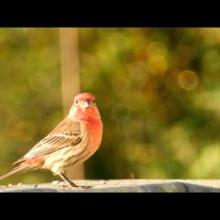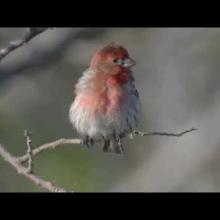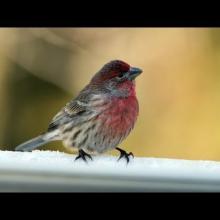

Join BirdNote tomorrow, November 30th!
Illustrator David Sibley and actor H. Jon Benjamin will face off in the bird illustration battle of the century during BirdNote's Year-end Celebration and Auction!
House Finches eat many kinds of seeds and fruits. A careful look at male House Finches at a feeder shows that, while most males show red feathering, some are decidedly more orange - and some even yellow. House Finches acquire their coloration from pigments known as carotenoids in the foods they eat.
BirdNote®
House Finches Red and Yellow
Written by Bob Sundstrom
This is BirdNote!
[Song of House Finch]
The sweet, jumbled song of a House Finch is a familiar sound across much of the country. [Song of House Finch]
House Finches eat many kinds of seeds and fruits. They readily flock to backyard feeders, and their short, thick bills are perfectly designed for hulling sunflower seeds at a brisk pace. Female House Finches are brown and heavily streaked overall, while males typically sport a red rump, breast, and headband. [House Finch call notes]
But a careful look at male House Finches at the feeder shows that, while most males show red feathering, some are decidedly more orange – and some even yellow. It turns out that House Finches acquire their coloration from pigments in the plant foods they eat. This is true for most birds with red-, orange-, or yellow-pigmented feathers. These tones each derive from a different organic pigment, known as carotenoids. So that yellow male House Finch standing out from all the red ones? Well, his attire reflects something he ate – or didn’t eat. [Song of House Finch]
###
Song and call of the House Finch provided by The Macaulay Library of Natural Sounds at the Cornell Lab of Ornithology, Ithaca, New York. Recorded by G.A. Keller
BirdNote's theme music was composed and played by Nancy Rumbel and produced by John Kessler.
Producer: John Kessler
Executive Producer: Chris Peterson
© 2015 Tune In to Nature.org March 2017/2019/2022 Narrator: Mary McCann
ID# old: 032306HOFIKPLU HOFI-01b







